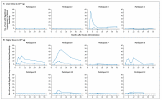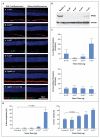Long-term effect of gene therapy on Leber's congenital amaurosis
- PMID: 25938638
- PMCID: PMC4497809
- DOI: 10.1056/NEJMoa1414221
Long-term effect of gene therapy on Leber's congenital amaurosis
Abstract
Background: Mutations in RPE65 cause Leber's congenital amaurosis, a progressive retinal degenerative disease that severely impairs sight in children. Gene therapy can result in modest improvements in night vision, but knowledge of its efficacy in humans is limited.
Methods: We performed a phase 1-2 open-label trial involving 12 participants to evaluate the safety and efficacy of gene therapy with a recombinant adeno-associated virus 2/2 (rAAV2/2) vector carrying the RPE65 complementary DNA, and measured visual function over the course of 3 years. Four participants were administered a lower dose of the vector, and 8 were administered a higher dose. In a parallel study in dogs, we investigated the relationship among vector dose, visual function, and electroretinography (ERG) findings.
Results: Improvements in retinal sensitivity were evident, to varying extents, in six participants for up to 3 years, peaking at 6 to 12 months after treatment and then declining. No associated improvement in retinal function was detected by means of ERG. Three participants had intraocular inflammation, and two had clinically significant deterioration of visual acuity. The reduction in central retinal thickness varied among participants. In dogs, RPE65 gene therapy with the same vector at lower doses improved vision-guided behavior, but only higher doses resulted in improvements in retinal function that were detectable with the use of ERG.
Conclusions: Gene therapy with rAAV2/2 RPE65 vector improved retinal sensitivity, albeit modestly and temporarily. Comparison with the results obtained in the dog model indicates that there is a species difference in the amount of RPE65 required to drive the visual cycle and that the demand for RPE65 in affected persons was not met to the extent required for a durable, robust effect. (Funded by the National Institute for Health Research and others; ClinicalTrials.gov number, NCT00643747.).
Figures



Comment in
-
Long-term effects of retinal gene therapy in childhood blindness.N Engl J Med. 2015 May 14;372(20):1954-5. doi: 10.1056/NEJMe1503419. Epub 2015 May 4. N Engl J Med. 2015. PMID: 25938534 No abstract available.
References
-
- den Hollander AI, Roepman R, Koenekoop RK, Cremers FP. Leber congenital amaurosis: genes, proteins and disease mechanisms. Prog Retin Eye Res. 2008;27:391–419. - PubMed
-
- Redmond TM, Yu S, Lee E, et al. Rpe65 is necessary for production of 11-cis-vitamin A in the retinal visual cycle. Nat Genet. 1998;20:344–51. - PubMed
-
- Dejneka NS, Surace EM, Aleman TS, et al. In utero gene therapy rescues vision in a murine model of congenital blindness. Mol Ther. 2004;9:182–8. - PubMed
Publication types
MeSH terms
Substances
Associated data
Grants and funding
LinkOut - more resources
Full Text Sources
Other Literature Sources
Medical
Miscellaneous
